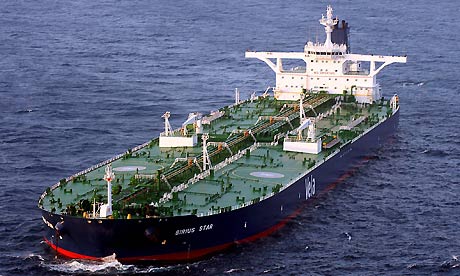 Its been said that it takes miles for a fully-loaded super-tanker to come to a stop, because an ordinary stop takes 20 minutes, and even an emergency, or “crash”, stop takes 14 minutes. But that is less than the blink of an eye compared to the time it will take to bring the emissions of CO2 to a stop.
Its been said that it takes miles for a fully-loaded super-tanker to come to a stop, because an ordinary stop takes 20 minutes, and even an emergency, or “crash”, stop takes 14 minutes. But that is less than the blink of an eye compared to the time it will take to bring the emissions of CO2 to a stop.
As Do the Math reminds us, in order to have some plausible chance (far short of certainty, by the way) of leaving global warming at under the 3.6°F that implies that the already ongoing climate catastrophe tips over into the super-catastrophe range, we need to keep additional CO2 emissions at under 565 gigatons. And we have computed reserves equivalent to 2,795 gigatons. So we must, by hook or by crook, find a way to refrain from consuming 80% of our CO2.
For the US, our main focus has to be on our energy emissions due to petroleum, coal, and natural gas, since 85.7% of our total CO2 emissions are due to energy production. As of 2011 41% of our emissions from energy production comes from petroleum emissions, 34% from coal, and 24% from natural gas. Of that 41% due to petroleum, 15% is from domestic petroleum production, and 26% from petroleum imports. So if the United States were to today achieve petroleum independence from carbon-neutral energy sources and energy savings, and totally replace coal combustion with carbon-neutral energy sources and energy savings, that would save 60% of the 86% of emissions from energy production, or 52% of the total. We would “only” have to cut the remaining energy-related emissions and the 14% from other sources by 60% to get to an equal proportional share of an 80% reduction.
However, the target we have to aim at is more ambitious than this. First, fossil fuels are non-renewable, and our timeline for the persistence of CO2 in the atmosphere is around a century. We don’t have a century’s worth of fossil fuels at the current rate of global consumption, so cutting back our consumption by 80% of the present rate is not enough.
And second, because of the time that it will take to switch to a low carbon emissions society, it is highly likely that by the time that a low carbon emissions society is within reach, we will have already emitted close to 565 gigatons.
This is why our target is no longer a “low net carbon emissions” society, but a “zero net carbon emissions” society, since we’ve likely already passed the “ordinary stop” stopping distance, and are coming up upon the “crash stop” stopping distance.

Recent Comments